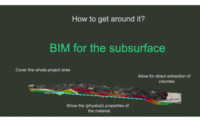Developers of the first open consensus standard for the exchange of building information models hope to grease the wheels of collaboration.
The non-proprietary National Building Information Model Standard-United States Version 2, or NBIMS-US V2, sets forward ways to promote interoperability between BIMs of different vendors and offers practice guidelines for users.
"Ideally, we want the standard embedded in the software so the user doesn't have to worry about it," said Deke Smith at the American Institute of Architects (AIA) 2012 National Convention and Design Exposition, held on May 17-19 in Washington, D.C.
Smith, who unveiled the new standard at the AIA convention, is executive director of the buildingSMART alliance, which is developing the standard. The alliance is part of the Washington, D.C.-based National Institute of Building Sciences.
Beta testers applaud the standard. "In the past, most standards have been relegated to monstrous volumes of paper or a very large pdf file," said Stephen J. Holzer, a consultant in web-based homebuilding for eM8s, Ann Arbor, Mich. "With Version 2, we have a navigable structure that allows stakeholders at most levels or disciplines the ability to discern topics that apply directly to them through any web browser."
The goal of NBIMS-US V2 is to provide a means of organizing and classifying electronic object data associated with a facility, from its cradle to its grave. The standard is intended to foster streamlined communication among owners, designers, material suppliers, constructors, facility managers and all stakeholders associated with the built environment.
A section for software developer-vendors offers reference standards developed by other allied standards organizations as well as exchange standards written and balloted by the NBIMS-US V2 project committee. For users, the standard contains "practice documents" to help them build BIMs for a facility.
Vendors are going to have to change their software to get true interoperability so that users can get the true advantages of BIM, said Smith, who predicts the coming of a whole new generation of software. He added that the major vendors are supporting the standard to varying degrees.
The alliance is continuing to work with more associations to develop new content. "We are just scratching the surface," Smith said, inviting all parties to send comments on Version 2 to dsmith@nibs.org.
Era of Guidance


Post a comment to this article
Report Abusive Comment